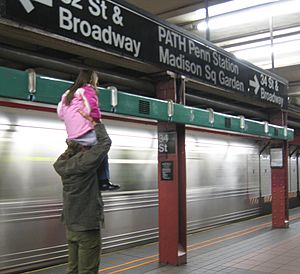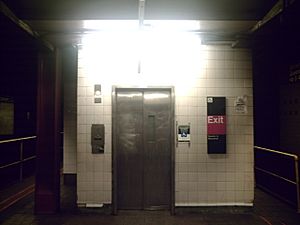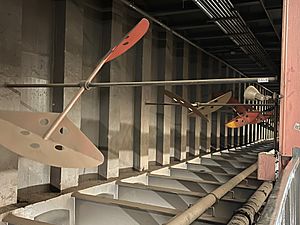34th Street–Herald Square station facts for kids
Quick facts for kids
34 Street–Herald Square
|
|||||||||||||
|---|---|---|---|---|---|---|---|---|---|---|---|---|---|
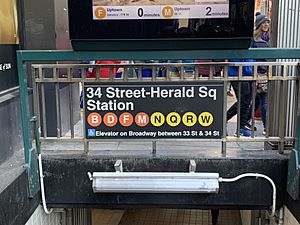
The station entrance as seen in 2019
|
|||||||||||||
| Station statistics | |||||||||||||
| Address | Intersection of West 34th Street, Broadway & Sixth Avenue New York, NY 10001 |
||||||||||||
| Borough | Manhattan | ||||||||||||
| Locale | Herald Square, Midtown Manhattan | ||||||||||||
| Coordinates | 40°44′58″N 73°59′17″W / 40.749338°N 73.987985°W | ||||||||||||
| Division | B (BMT/IND) | ||||||||||||
| Line | IND Sixth Avenue Line BMT Broadway Line |
||||||||||||
| Services | B weekdaysonly (weekdays until 11:00 p.m.) D alltimes (all times) F alltimes (all times) M weekdaysonly (weekdays until 11:00 p.m.) N alltimes (all times) Q alltimes (all times) R allexceptnights (all except late nights) W weekdaysonly (weekdays only) |
||||||||||||
| Transit connections | |||||||||||||
| Structure | Underground | ||||||||||||
| Levels | 2 | ||||||||||||
| Other information | |||||||||||||
| Opened | July 1, 1948 | ||||||||||||
| Station code | 607 | ||||||||||||
| Accessible | |||||||||||||
| Traffic | |||||||||||||
| Passengers (2019) | 39,385,436 |
||||||||||||
| Rank | 3 out of 425 | ||||||||||||
|
|||||||||||||
|
|||||||||||||
|
|||||||||||||
The 34th Street–Herald Square station is a very busy underground subway station in New York City. It's located in Midtown Manhattan at Herald Square, where 34th Street, Broadway, and Sixth Avenue meet. This station is a complex, meaning it combines two different subway lines: the BMT Broadway Line and the IND Sixth Avenue Line.
Many different subway trains stop here, including the D, F, N, and Q trains all the time. The R train stops here most of the time, and the B, M, and W trains stop here on weekdays. The station is one of the busiest in the entire New York City subway system, with millions of passengers using it every year. It's a key spot for getting around Manhattan!
Contents
History of the Station
The 34th Street–Herald Square station has a long history, built in different stages to connect more parts of New York City.
Building the Broadway Line
The first part of this station to open was the Broadway Line platforms. These were planned way back in 1907 as part of a big project to expand the subway. The company that built and ran these lines was called the Brooklyn Rapid Transit Company (BRT), later known as the Brooklyn–Manhattan Transit Corporation (BMT).
Construction for this section started in August 1914. The Broadway Line platforms at 34th Street officially opened on January 5, 1918. Even before it opened, people thought it would be one of the most important subway stations because it connected to several busy streets.
Adding the Sixth Avenue Line
Later, New York City decided to build its own subway system, called the Independent Subway System (IND). This new system was designed to add even more subway lines and connect different parts of the city. The IND Sixth Avenue Line was planned to replace an old elevated train line that ran above Sixth Avenue.
Building the Sixth Avenue Line was a big challenge. Workers had to dig tunnels around existing train lines and even under some of them. They used a method called "cut-and-cover," which means digging a trench, building the tunnel, and then covering it up. They also had to use small amounts of dynamite for blasting to avoid damaging nearby buildings.
The IND's 34th Street–Herald Square station opened on December 15, 1940. This new line helped reduce crowding on other subway lines and made it easier for people to travel across the city.
Station Updates Over the Years
Over time, the station has been updated and improved.
Connecting More Trains
In the 1960s, a major project called the Chrystie Street Connection was built. This project added new express tracks and connections that allowed more trains to travel into Manhattan during busy hours. It also changed how some trains, like the B and D, ran, connecting them to different lines in Brooklyn.
Modernizing the Station
The station complex was updated in the late 1970s. This renovation improved the station's structure and made it look more modern. Old wall tiles and signs were replaced, and new lighting was installed.
In the early 1990s, the station got another big upgrade. This time, it was made accessible for people with disabilities, following the Americans with Disabilities Act of 1990 (ADA). This included adding elevators and making other improvements. The station also received new wall and floor tiles, better lighting, and a new public address system. This large project was finished in 1996.
To save energy, the MTA installed special escalators in 2008 that can change their speed. Also, the old token booths, where people bought subway tokens, were closed in 2005 after MetroCards became the main way to pay for fares.
Station Layout and Features
The 34th Street–Herald Square station is a large underground complex with different levels and many ways to get around.
Inside the Station
The station has a long area above the platforms called a mezzanine. This is where you'll find fare control (where you pay to enter), ticket machines, and ways to transfer between the two subway lines. There are also elevators and escalators to help people get to the platforms.
The station also features some cool artwork as part of the MTA Arts & Design program.
- Radiant Site by Michele Oka Doner uses 11,000 gold-colored tiles on a long wall. The artist wanted to fill the underground space with light.
- Halo by Nicholas Pearson has seven round shapes made of coiled aluminum rods hanging above the mezzanine.
- Yab-Yum by David Provan is a sculpture above the northbound IND tracks. It has fourteen large red paddles that used to spin when trains arrived or left, creating wind.
Station Entrances and Exits
The station has many entrances and exits that connect to the busy streets above.
Main Entrances
At the north end of the main mezzanine, there's an exit at 35th Street. It has stairs leading to different corners of Sixth Avenue and 35th Street.
The main entrances are at Broadway, Sixth Avenue, and 34th Street. There are entrances near famous stores like Macy's Herald Square. One entrance on the west side of 34th Street is open all the time and even has an entrance to an underground restaurant. There's also a long path with an elevator that connects to the PATH train station at 33rd Street.
Southern Entrances
At the south end of the Sixth Avenue level, there's another mezzanine. This area has stairs leading to each platform. You can also find an entrance that leads directly into the basement levels of J. C. Penney in the Manhattan Mall. There are escalators that take you to the front entrance of the mall too.
Connecting Passageways
The station used to have some long underground passageways that are now closed.
Old Gimbels Passageway
There was once a passageway under 33rd Street that connected to Penn Station, which is a block west. This was called the "Gimbels passageway" because it was next to the Gimbels department store. It opened in 1920 and was about 800 feet long. Over time, for safety reasons, this passageway was closed in 1986. Now, people have to walk above ground to get to Penn Station.
Passageway to Bryant Park
Another long passageway used to extend north from the IND station's mezzanine all the way to the 42nd Street station. This passageway was outside the paid area of the subway. It was very long, about 35 feet wide, and had entrances at different streets. However, this passageway was closed in 1991 due to safety concerns.
BMT Broadway Line Platforms
|
34 Street–Herald Square
|
|||||||||||||||
|---|---|---|---|---|---|---|---|---|---|---|---|---|---|---|---|
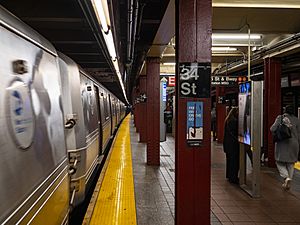
Southbound BMT platform
|
|||||||||||||||
| Station statistics | |||||||||||||||
| Division | B (BMT) | ||||||||||||||
| Line | BMT Broadway Line | ||||||||||||||
| Services | N alltimes (all times) Q alltimes (all times) R allexceptnights (all except late nights) W weekdaysonly (weekdays only) |
||||||||||||||
| Platforms | 2 island platforms cross-platform interchange |
||||||||||||||
| Tracks | 4 | ||||||||||||||
| Other information | |||||||||||||||
| Opened | January 5, 1918 | ||||||||||||||
| Station code | 012 | ||||||||||||||
| Accessible | |||||||||||||||
| Wireless service | |||||||||||||||
| Opposite-direction transfer available | Yes | ||||||||||||||
| Station succession | |||||||||||||||
|
|||||||||||||||
The BMT Broadway Line part of the 34th Street–Herald Square station is an express station. This means it has four tracks: two for local trains and two for express trains. It also has two island platforms, which are platforms with tracks on both sides.
Each platform has stairs and an elevator that lead up to the main mezzanine. North of the station, there are special track switches called "diamond crossovers." These allow N trains to switch between express and local tracks during weekdays.
Sometimes, N trains heading to Queens might wait at this station. This happens because they need to switch tracks just north of here. It can be confusing for riders who might run back and forth on the platform trying to catch the train that leaves first! This is sometimes called "The Subway Shuffle."
In 1996, an artist named Christopher Janney created an art piece called "REACH New York, An Urban Musical Instrument." It has green racks with sensors on both platforms. If you wave your hands in front of the sensors, they make sounds!
IND Sixth Avenue Line Platforms
|
34 Street–Herald Square
|
|||||||||||||
|---|---|---|---|---|---|---|---|---|---|---|---|---|---|
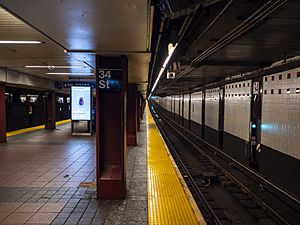
Northbound IND Platform
|
|||||||||||||
| Station statistics | |||||||||||||
| Division | B (IND) | ||||||||||||
| Line | IND Sixth Avenue Line | ||||||||||||
| Services | B weekdaysonly (weekdays until 11:00 p.m.) D alltimes (all times) F alltimes (all times) M weekdaysonly (weekdays until 11:00 p.m.) |
||||||||||||
| Platforms | 2 island platforms cross-platform interchange |
||||||||||||
| Tracks | 4 | ||||||||||||
| Other information | |||||||||||||
| Opened | December 15, 1940 | ||||||||||||
| Station code | 227 | ||||||||||||
| Accessible | |||||||||||||
| Wireless service | |||||||||||||
| Opposite-direction transfer available | Yes | ||||||||||||
| Station succession | |||||||||||||
|
|||||||||||||
The IND Sixth Avenue Line part of the 34th Street–Herald Square station is also an express station. It has four tracks and two island platforms, just like the BMT level. The elevators to the mezzanine are at the north end of this station. The stairs leading to the Manhattan Mall entrance are at the south end.
The platforms have many stairs and escalators that connect to the main mezzanine above. There are also stairs on both platforms that lead to a ramp, which then goes to the mezzanine.
North of this station, there are many track switches. These allow trains to change tracks, which is useful during construction or when trains need to end their trip here.
Above the northbound local tracks, you can see the Yab-Yum sculpture by David Provan. It was created in 1992 and has fourteen large paddles painted red. When trains used to arrive or leave, the wind from them would make the paddles spin!
Notable Places Nearby
The 34th Street–Herald Square station is located near many famous New York City landmarks:
- Empire State Building, just one block east of the 34th Street entrances.
- Manhattan Mall, which has an entrance directly connected to the station at 32nd Street.
- Herald Square, the public space right between the 34th Street entrances.
- Macy's Herald Square, a very famous department store, located near the northwestern entrance at 34th Street.
- Penn Station and Madison Square Garden, both one block west of the 32nd Street entrance.
Images for kids
See also
 In Spanish: Calle 34–Herald Square (metro de Nueva York) para niños
In Spanish: Calle 34–Herald Square (metro de Nueva York) para niños





